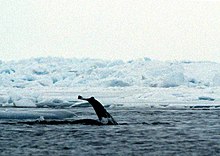Polynya


A polynya (
There are two main types of polynyas: coastal polynyas, which can be found year-round near the Antarctic and Arctic coasts and are mainly created by strong winds pushing the ice away from the coast, and mid-sea or open-ocean polynyas, which may be found more sporadically in the middle of ice pack in certain locations, especially around Antarctica. These locations are generally preconditioned by certain oceanic dynamics.
One of the most famous mid-sea polynyas is the Weddell Polynya, also known as the Maud Rise Polynya,[4] which occurs in the Lazarev Sea over the Maud Rise seamount. It was first spotted in September 1973 and persisted through multiple winters (1974–1976), and recently recurred in September 2017.[5]
Formation
Coastal polynyas are formed through two main processes:
- A sensible heat polynya is thermodynamically driven, and typically occurs when warm water freezing point. This reduces ice production and may stop it altogether.
- A latent heat polynya is formed through the action of pack ice is driven away from the coast, which leaves an area of open water within which new ice is formed. This new ice is then also herded downwind toward the first-year pack ice. When it reaches the pack ice, the new ice is consolidated onto the pack ice. This process continues over time. Latent heat polynyas are therefore a major source of sea ice production in the Antarctic.[6]
Latent heat polynyas are regions of high ice production and therefore are possible sites of dense water production in both
Mid-sea polynyas are formed when specific atmospheric conditions occur over preconditioned oceanographic areas. Such atmospheric conditions should favor ice drift in opposite directions to open the ice pack.

Antarctic Bottom Water (AABW)
Ecology
Some polynyas, such as the
Polynya blooms
The presence of open water in an otherwise ice-covered area can result in a localized marine algal bloom, also referred to as a polynya bloom.[13] While algal communities are often found under sea ice, as evidenced by ice algae, the rate of phytoplankton growth is substantially higher in the open water of a polynya.[14] The primary drivers of polynya blooms are sunlight and nutrients. Specifically, the lack of sea ice allows light, a necessary component for photosynthesis, to penetrate deeper into the water and enable elevated phytoplankton growth compared to the surrounding ice-covered waters.[13] Furthermore, polynya formation is typically associated with upwelling, a process that transports nutrient-rich water from the ocean bottom towards the surface.[15] This influx of nutrients coupled with increased light levels often results in polynya blooms.[13]
Biological production

In general, polynyas tend to be more biologically productive as a result of containing more phytoplankton than the surrounding water.[16] Therefore, due to the role of primary producers as the foundation of the marine food web, polynyas are a critical food source for a variety of organisms such as fish, birds, and marine mammals.[16] Listed below are several examples of the importance of polynyas to polar communities.
- Increased seal mortality rates were observed during years when the Ross Sea Polynya did not open.[13]
- In eastern Antarctica, 91% of Adélie penguin colonies are linked to a coastal polynya, where polynya size often correlates to colony size.[16]
- The presence of polynyas in McMurdo Sound provides an ice-free area where penguins can feed, directly effecting the survival of the Cape Royds penguin colony.[17]
- The downward transport of carbon (in the form of marine snow) from the surface to the seafloor associated with polynya blooms provides the nutrients necessary to sustain rich benthic communities.[18]
Human dependency
Polynyas have also supported human populations throughout history. For example, the North Water Polynya, the largest and most biologically productive Arctic polynya, serves as a critical source of food in an otherwise barren region, enabling the existence of high-latitude human communities in the region for thousands of years.[19] It may have served as a stepping stone for the original settlers of Greenland as they traversed through what is now northern Canada 4500 years ago.[19] There are also indications that the North Water Polynya has aided Thule, Inuit, Norse, and western explorers throughout history.[19] Today, the North Water Polynya enables the existence of Greenland's northernmost town, Qaanaaq.[20]
When submarines of the U.S. Navy made expeditions to the
See also
References
- ^ W.J. Stringer and J.E. Groves. 1991. Extent of Polynyas in the Bering and Chukchi Seas
- ^ Sherard Osborn, Peter Wells and A. Petermann. 1866. Proceedings of the Royal Geographical Society of Australia, Vol 12 no 2 1867–1868 pp 92–113 On the Exploration of the North Polar Region
- ^ polynya, Merriam Webster Dictionary
- S2CID 149497432.
- ^ Weddell Polynya, NASA, 1999
- ISSN 2156-2202.
- S2CID 149497432.
- ISSN 2156-2202.
- S2CID 128716199.
- doi:10.1038/ngeo1738.
- doi:10.1038/ngeo1738.
- ^ C. Michael Hogan. 2008 Polar Bear: Ursus maritimus, Globaltwitcher.com, ed. N. Stromberg Archived 2008-12-24 at the Wayback Machine
- ^ a b c d Earth Science Data Systems, NASA (15 March 1995). "Earthdata". Earthdata. Retrieved 2022-10-06.
- ISBN 9780444529527. Retrieved 2022-10-06.
- ^ ISSN 0148-0227.
- ^ "Penguins in high latitudes". NZETC. 12 June 2014.
- PMID 29453356.
- ^ PMID 29516442.
- ^ "Qaanaaq". Visit Greenland. Retrieved 2022-10-06.
- ^ Tales of a Cold War Submariner by Dan Summitt, 2004.
External links
- Polar cyclones at the origin of the reoccurrence of the Maud Rise Polynya in austral winter 2017 (NOW) at agupubs.onlinelibrary.wiley.com (Error: unknown archive URL) (archived 24 April 2019)
- International North Water Polynya Study (NOW) at the Wayback Machine (archived 11 February 2009)
- Polynya north of Alaska at NASA Earth Observatory
